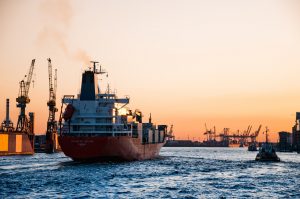2 Major Factors to Affect Freight Rates in 2020
 Freight rates in the international shipping industry are always volatile, especially for small to medium shippers who play the spot market for their import and export pricing.
Freight rates in the international shipping industry are always volatile, especially for small to medium shippers who play the spot market for their import and export pricing.
There are many factors that affect freight rates, but in 2020 there are two factors that stand out as likely being the biggest factors in determining how much businesses will pay for their ocean freight shipping.
What’s interesting is these factors are set to push freight rates in opposite directions. In today’s article, we discuss those factors and I give my prediction for how freight rates will behave in 2020.
Factor #1 — Overcapacity
If you were to look back over the last decade, or even two, you would likely find that the biggest factor plaguing ocean freight carriers is overcapacity. You would think that the executives of the world’s major shipping lines failed Economics 101 for how poorly they’ve managed supply and demand in the ocean freight sector.
Capacity has outpaced demand so much in ocean freight shipping that we’ve watched freight rates get pushed to unhealthy lows that have caused billions of dollars in losses for shipping lines and carrier competition to vastly shrink through mergers, buyouts, alliances, and even bankruptcy.
Last year, however, especially as the peak season (which was smaller than usual thanks to a bloated peak season the year before and frontloading of shipments to beat tariff hike deadlines) carriers showed better than normal discipline when it came to capacity management.
One would think the industry finally learned its supply and demand economy lessons and would stop overcapacity from plaguing shipping lines moving forward. Drewry, however, says that’s not the case. The shipping research company predicts 2020 will be another year marked by overcapacity.
Mike Wackett reports in the Loadstar:
2020 will prove another challenging year for ocean carriers in terms of capacity management, according to Drewry.
…
Drewry calculates that 1.2m teu of capacity will be added to the fleet this year, of which almost half comprises 23 20,000-plus teu ULCVs for HMM, CMA CGM and MSC.
According to Alphaliner data, the containership fleet grew by 4% in 2019, to 23.2m teu of capacity (5,337 ships), resulting from 1.06m teu of newbuild deliveries against 207,000 teu of ships sold for scrap.
And with demand growth predicted to remain weak, the ‘challenge’ from the orderbook is ever present.
An article by Chris Dupin in American Shipper also highlights Drewry’s projection of overcapacity for 2020:
How severe is the overcapacity? Drewry has created a proprietary global supply-demand index for the container shipping industry, and it said anytime it is below 100 represents overcapacity. Its quarterly Container Forecaster report calls for a tiny decrease of 0.4 points to 90.6 in 2020, highlighting “just how far carriers have to go to compensate for the industry’s structural overcapacity and reach a comfortable balance that will promote sustainable freight rate gains.”
Factor #2 — IMO 2020
The other big factor affecting freight rates this year is the newly-in-effect regulation known as IMO 2020, putting a 0.5% sulfur cap on ships’ fuel. While overcapacity creates downward pressure on freight rates, IMO 2020 pushes freight rates up in 2020.
Last week, we blogged about how things are going in the early days of the transition to IMO 2020. While freight rate increases have been only modestly bigger than recent historical gains this time of year, increased fuel costs are expected to cause shippers to see more freight rate increases as the year continues, especially in the form of low sulfur surcharges.
Costs that carriers incur through the installation of scrubbers that allow ships to use cheaper fuel will also be pushed off on shippers as much as shipping lines are able.
In fact, the lack of transparency from shipping lines has shippers and other logistics professionals concerned that low sulfur fuel fees will be used to hike freight rate prices beyond actual rises in fuel costs. That growing controversy is one we’ll cover in an upcoming blog.
Which Factor Will Win?
With overcapacity creating downward pressure on freight rates and IMO 2020 creating upward pressure, the question becomes, “Which factor will be greater?” Will shippers like freight rates in 2020 or hate them?
This time of year, especially once the Chinese New Year hits, often sees a bit of a lull in international shipping demand. This smaller demand combined with carriers already imposing low sulfur fuel fees and rate increases before IMO even went into effect on January 1st probably helped keep freight rates from seeing the hikes that many expected at the beginning of the year.
It is not likely we’ll see overcapacity and IMO 2020 balancing each other out through the year.
My money is on IMO 2020 becoming the larger factor, keeping prices higher than normal through most of 2020.
Despite Drewry’s warning of overcapacity in 2020, the research and consulting company seems to think carriers will be able to manage their overcapacity better than they have many years in the past. Part of what will help them do that is ships being out of commission in order to get scrubbers installed because of IMO 2020.
Last month, we published a blog post that highlighted how ships are stuck waiting for scrubbers to be installed. Installation is taking longer than expected, and that takes capacity off the water. So even though IMO 2020 creates upward pressure on rates, it’s a complicated enough issue that there are factors within it that help keep freight rates in check.
Of course, carriers need more than just the capacity of ships waiting for scrubber installation off the water. Sure, there will be some ship scrapping, but the big strategy shipping lines have been undertaking to check capacity is blank sailing.
There was a ton of blank sailing, which is when a sailing of a cargo ship is cancelled, last year. And it looks like carriers are planning to do even more of it this year.
Wackett’s Loadstar article gives details:
Drewry’s data reveals there were a massive 253 voided east-west sailings by the three alliances last year, significantly up on the 145 cancelled in 2018. It said container lines had become “very adept at switching capacity around and hiding it when necessary”.
Indeed, one carrier source told The Loadstar recently the line intended to be “more aggressive” in its blanking programme this year.
“We cannot afford to let it (supply) get out of control again this year, and we must not be fooled again by over optimistic assessments for the peak season,” he said.
“If we don’t have enough ships, so be it, but at least those that do sail will make some money,” he added.
It’s not surprising that the carrier who shared the plan to be more aggressive with blank sailing did so anonymously. Blank sailings are very unpopular with shippers. And for good reason. Blank sailings can happen suddenly with little to no warning. Shippers are often left in the dark about where their cargo is. Worse, the delays blank sailings cause can be quite costly for shippers.
Prediction of Freight Rate Behavior in 2020
While the two major factors affecting freight rates in 2020 are pushing in opposite directions, the factors making ocean freight more expensive appear to be set to outweigh those that would make it less expensive.
My expectations are that freight rates will be generally higher in 2020 than 2019 and freight rate growth in general will end up being moderately more than we’ve seen in recent years.
However, there are x factors that could change that. It would not be surprising to see carriers fail to curb the overcapacity and engage in some pricing wars that put considerable downward pressure on freight rates. We’ve certainly seen carriers do this in recent years.
As controversy over low sulfur fees grows, carriers could find it hard to maintain rate increases and see them undercut by the competition. There’s even growing tension between 2M alliance members Maersk and MSC, which also happen to be the two biggest carriers in the world, right now that could factor largely into how the freight rate market plays out in 2020.
Expect volatility. Expect freight rate growth. And be ready for the unexpected.
Keep up on what’s happening in international shipping by checking back in here at Universal Cargo’s blog. We have new posts every Tuesday and Thursday. And we’re always ready to give you a quote on importing or exporting your goods.





Dear Jared Vineyard your blog is very informative. Thanks.